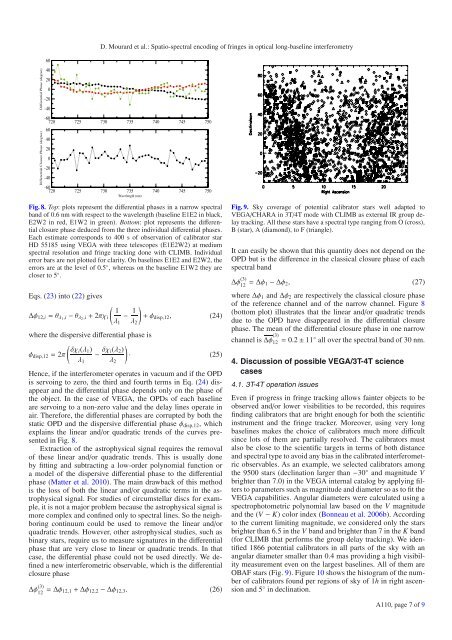Spatio-spectral encoding of fringes in optical long ... - GSU Astronomy
Spatio-spectral encoding of fringes in optical long ... - GSU Astronomy
Spatio-spectral encoding of fringes in optical long ... - GSU Astronomy
You also want an ePaper? Increase the reach of your titles
YUMPU automatically turns print PDFs into web optimized ePapers that Google loves.
D. Mourard et al.: <strong>Spatio</strong>-<strong>spectral</strong> <strong>encod<strong>in</strong>g</strong> <strong>of</strong> <strong>fr<strong>in</strong>ges</strong> <strong>in</strong> <strong>optical</strong> <strong>long</strong>-basel<strong>in</strong>e <strong>in</strong>terferometry60Differential Phase (degree)Differential Closure Phase (degree)40200-20-40-60720 725 730 735 740 745 7506040200-20-40-60720 725 730 735 740 745 750Wavelength (nm)Fig. 8. Top: plots represent the differential phases <strong>in</strong> a narrow <strong>spectral</strong>band <strong>of</strong> 0.6 nm with respect to the wavelength (basel<strong>in</strong>e E1E2 <strong>in</strong> black,E2W2 <strong>in</strong> red, E1W2 <strong>in</strong> green). Bottom: plot represents the differentialclosure phase deduced from the three <strong>in</strong>dividual differential phases.Each estimate corresponds to 400 s <strong>of</strong> observation <strong>of</strong> calibrator starHD 55185 us<strong>in</strong>g VEGA with three telescopes (E1E2W2) at medium<strong>spectral</strong> resolution and fr<strong>in</strong>ge track<strong>in</strong>g done with CLIMB. Individualerror bars are not plotted for clarity. On basel<strong>in</strong>es E1E2 and E2W2, theerrors are at the level <strong>of</strong> 0.5 ◦ , whereas on the basel<strong>in</strong>e E1W2 they arecloser to 5 ◦ .Eqs. (23)<strong>in</strong>to(22)givesΔφ 12,i = θ λ1 ,i − θ λ2 ,i + 2πχ i( 1λ 1− 1 λ 2)+ φ disp,12 , (24)where the dispersive differential phase is( δχi (λ 1 )φ disp,12 = 2π − δχ )i(λ 2 )· (25)λ 1 λ 2Hence, if the <strong>in</strong>terferometer operates <strong>in</strong> vacuum and if the OPDis servo<strong>in</strong>g to zero, the third and fourth terms <strong>in</strong> Eq. (24) disappearand the differential phase depends only on the phase <strong>of</strong>the object. In the case <strong>of</strong> VEGA, the OPDs <strong>of</strong> each basel<strong>in</strong>eare servo<strong>in</strong>g to a non-zero value and the delay l<strong>in</strong>es operate <strong>in</strong>air. Therefore, the differential phases are corrupted by both thestatic OPD and the dispersive differential phase φ disp,12 ,whichexpla<strong>in</strong>s the l<strong>in</strong>ear and/or quadratic trends <strong>of</strong> the curves presented<strong>in</strong> Fig. 8.Extraction <strong>of</strong> the astrophysical signal requires the removal<strong>of</strong> these l<strong>in</strong>ear and/or quadratic trends. This is usually doneby fitt<strong>in</strong>g and subtract<strong>in</strong>g a low-order polynomial function ora model <strong>of</strong> the dispersive differential phase to the differentialphase (Matter et al. 2010). The ma<strong>in</strong> drawback <strong>of</strong> this methodis the loss <strong>of</strong> both the l<strong>in</strong>ear and/or quadratic terms <strong>in</strong> the astrophysicalsignal. For studies <strong>of</strong> circumstellar discs for example,it is not a major problem because the astrophysical signal ismore complex and conf<strong>in</strong>ed only to <strong>spectral</strong> l<strong>in</strong>es. So the neighbor<strong>in</strong>gcont<strong>in</strong>uum could be used to remove the l<strong>in</strong>ear and/orquadratic trends. However, other astrophysical studies, such asb<strong>in</strong>ary stars, require us to measure signatures <strong>in</strong> the differentialphase that are very close to l<strong>in</strong>ear or quadratic trends. In thatcase, the differential phase could not be used directly. We def<strong>in</strong>eda new <strong>in</strong>terferometric observable, which is the differentialclosure phaseΔφ (3)12 =Δφ 12,1 +Δφ 12,2 − Δφ 12,3 . (26)Fig. 9. Sky coverage <strong>of</strong> potential calibrator stars well adapted toVEGA/CHARA <strong>in</strong> 3T/4T mode with CLIMB as external IR group delaytrack<strong>in</strong>g. All these stars have a <strong>spectral</strong> type rang<strong>in</strong>g from O (cross),B (star), A (diamond), to F (triangle).It can easily be shown that this quantity does not depend on theOPD but is the difference <strong>in</strong> the classical closure phase <strong>of</strong> each<strong>spectral</strong> bandΔφ (3)12 =Δφ 1 − Δφ 2 , (27)where Δφ 1 and Δφ 2 are respectively the classical closure phase<strong>of</strong> the reference channel and <strong>of</strong> the narrow channel. Figure 8(bottom plot) illustrates that the l<strong>in</strong>ear and/or quadratic trendsdue to the OPD have disappeared <strong>in</strong> the differential closurephase. The mean <strong>of</strong> the differential closure phase <strong>in</strong> one narrowchannel is Δφ (3)12 = 0.2 ± 11 ◦ all over the <strong>spectral</strong> band <strong>of</strong> 30 nm.4. Discussion <strong>of</strong> possible VEGA/3T-4T sciencecases4.1. 3T-4T operation issuesEven if progress <strong>in</strong> fr<strong>in</strong>ge track<strong>in</strong>g allows fa<strong>in</strong>ter objects to beobserved and/or lower visibilities to be recorded, this requiresf<strong>in</strong>d<strong>in</strong>g calibrators that are bright enough for both the scientific<strong>in</strong>strument and the fr<strong>in</strong>ge tracker. Moreover, us<strong>in</strong>g very <strong>long</strong>basel<strong>in</strong>es makes the choice <strong>of</strong> calibrators much more difficults<strong>in</strong>ce lots <strong>of</strong> them are partially resolved. The calibrators mustalso be close to the scientific targets <strong>in</strong> terms <strong>of</strong> both distanceand <strong>spectral</strong> type to avoid any bias <strong>in</strong> the calibrated <strong>in</strong>terferometricobservables. As an example, we selected calibrators amongthe 9500 stars (decl<strong>in</strong>ation larger than −30 ◦ and magnitude Vbrighter than 7.0) <strong>in</strong> the VEGA <strong>in</strong>ternal catalog by apply<strong>in</strong>g filtersto parameters such as magnitude and diameter so as to fit theVEGA capabilities. Angular diameters were calculated us<strong>in</strong>g aspectrophotometric polynomial law based on the V magnitudeand the (V − K) color <strong>in</strong>dex (Bonneau et al. 2006b). Accord<strong>in</strong>gto the current limit<strong>in</strong>g magnitude, we considered only the starsbrighter than 6.5<strong>in</strong>theV band and brighter than 7 <strong>in</strong> the K band(for CLIMB that performs the group delay track<strong>in</strong>g). We identified1866 potential calibrators <strong>in</strong> all parts <strong>of</strong> the sky with anangular diameter smaller than 0.4 mas provid<strong>in</strong>g a high visibilitymeasurement even on the largest basel<strong>in</strong>es. All <strong>of</strong> them areOBAF stars (Fig. 9). Figure 10 shows the histogram <strong>of</strong> the number<strong>of</strong> calibrators found per regions <strong>of</strong> sky <strong>of</strong> 1h <strong>in</strong> right ascensionand 5 ◦ <strong>in</strong> decl<strong>in</strong>ation.A110, page 7 <strong>of</strong> 9












